Path of Exile is the Diablo II sequel you've always wanted
Prepare for a relapse of your demon-killing addiction
The rightful heir to the throne?

Diablo III is by no means a bad game, but less than a year after its debut, our interest in it couldnt be lower. Thats a shame, because Diablo II kept us entertained for years with its addictive feedback loop--make a character, kill monsters, get loot, deck ourselves out, make a new character. If Blizzard itself couldnt craft the ultimate Diablo clone, who could? Who would be bold enough to create a game that could fill the click-click, hack-nslash hole in our hearts? Runic Games? Maybe. But even better, its indie studio Grinding Gear Games, taking everything we loved about our Diablo II days and bringing it into the modern action RPG era with their first game: Path of Exile.
Sure, plenty have cited Diablo II as a reference--but the free-to-play Path of Exile (or PoE) appears to have Diablo blood coursing through its obsession-forming veins. The game is in open beta as of today--but like us, theres a chance youve been burned by so-called Diablo successors before. Thats why weve laid out why PoE looks like the real deal. Its time you got to know the game you didnt know you wanted
Massive skill tree enables deep customization
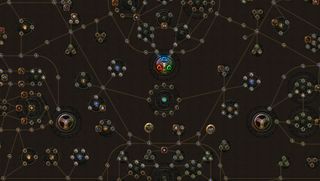
A major part of Diablo IIs appeal came from each class' three iconic skill trees, which encouraged the player to devise new builds and discover synergies that could define your entire playstyle. Diablo IIIs simplified Rune system replaced those trees with a straightforward, somewhat limiting array of options, which ensured that only a fraction of the abilities would actually see any use in high-level play. But Grinding Gear Games isnt afraid to give PoE players a little free reign, citing Magic: The Gatherings wealth of complex card combos as a source of design inspiration.
Instead of limiting player choice, Grinding Gear would be delighted if players endeavored to develop game-breaking skill combos with the six hybrid-enabling classes (even choosing to spotlight these builds). Thats evidenced by the massive, wide-open constellation that is the Passive skill tree, and the fact that all Active spells come in the form of gems that you can freely add and remove to your gear. Similar to the renowned Sphere Grid from Final Fantasy X, PoE lets any class acquire any ability, provided you plan your path far enough ahead.
No easy respecs means you actually bond with your character

PoE isnt going to just hand you a clean slate whenever you want it. If you mess up a passive skill point, youll need to earn a respec point from quests or use the aptly named Orb of Regret item to get a do-over. Diablo II vets know all about the horrors of accidentally messing up their build, and how starting a new character was an entirely acceptable option. It sounds harsh, by todays standards--so why is this a good thing?
Without the ability to remold your entire build with a single thought, youll actually get the chance to get attached to your character, weaving a self-satisfying narrative around your monster-slaying champion and perfecting the subtleties of their playstyle. Diablo IIIs characters felt very ephemeral and impersonal, seeing as you could change their entire skillset in an instant to jump on the flavor-of-the-month bandwagon. PoE makes you live with your decisions, leaving it up to you whether you want to obsessively plan every last point of your build, or just go with the skill tree flow and see where it takes you.
The gritty, but still beautiful, art style

Emo jokes aside, Diablo IIIs aesthetics incited the hardcore Diablo II community, who decried the visuals for being too cartoony to fit a demonic dungeon-crawler. The end result, though pretty, felt a little detached from its predecessors, and had more than a hint of World of Warcrafts graphical DNA in it. Until now, there hasnt been a game that captured the flavor of D2s render-based sprites without looking abysmal at high resolution.
Sign up to the GamesRadar+ Newsletter
Weekly digests, tales from the communities you love, and more
Path of Exile pulls off this difficult balance with its own unique look, which combines traditional-looking character models with some gorgeous high-res textures. Your enemies come in monstrous, imaginative forms, but the graphics give even the strangest-looking creature a touch of realism. If youve played Titan Quest, PoE looks similar, but with a far-superior HUD and flashier spell effects.
Fully randomized maps
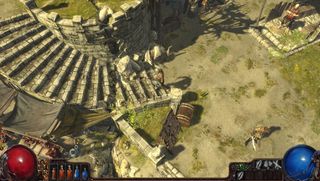
Unexpected level layouts arent the only component of replayability--but they definitely go a long way. Like Diablo II before it, PoE randomizes the game map every time you boot it up, ensuring that you wont mindlessly breeze your way through to a boss fight. The tilesets themselves are nice and varied, too; after stabbing and spellcasting your way through a murky catacomb filled with armored crab monsters, its refreshing to step out of the dark caves and into a bright, sun-kissed field littered with ornery goatman mages.
Diablo IIIs environments were a bit of a letdown, reducing the random elements to small, auxiliary additions that may or may not show up on the map. With any luck, PoEs unpredictable map layouts will keep things interesting no matter how many times youve run through any given zone.
The level cap is a trial, not a prerequisite
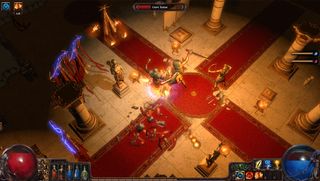
Diablo III capped characters at level 60, which some fanatical gamers were able to hit in a little over two days. The cap was low and easy to hit by design, because if you wanted any chance at obtaining high-end loot in the Inferno difficulty, attaining the max level was a requirement. This flew in the face of what Diablo II players had come to expect, where level 99 characters were few and far between (and even fewer were actually legitimate). Instead of acting as a barrier to content, the level cap was more like a badge of pride and/or having no life.
PoE plays off that same concept, capping character level at 100 with the expectation that very few players will actually reach it. Thats fine by us, because end game content is totally viable with a level 80-or-so character. Its just nice to know that no matter how ridiculously hardcore you are, its impossible to conquer this game in a week.
Hardcore players will be in heaven

Many a hardcore action RPG gamer was forged in the fires of Diablo II, where perma-death and incredible challenge created an atmosphere of intense risk offset by reward in the form of reputation. Like any self-respecting Diablo descendant, PoE offers players a Hardcore option to test their mettle; this system also uses the ingenious change of permanently shifting Hardcore characters to the Normal servers upon death, instead of banishing them to digital oblivion. This makes Hardcore play that much more appealing to gamers afraid of trashing a huge time investment with a single mistake.
PoE also introduces the concept of Leagues, which act like separate ladders with individual rule sets. These leagues will be a godsend to the hardest of the hardcore players, thanks to the game-altering changes they offer (with plans to let players create their own leagues later down the line). For instance, the Cut-throat leagues let you attack any player on sight; kill them, and youll be able to pick the corpse clean of all their items. Mix Cut-throat with Hardcore, and it sounds like one of the most extreme, high-stakes RPG experiences imaginable.
A unique barter system
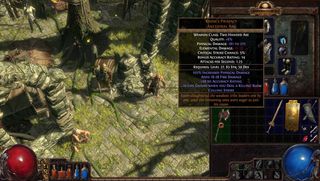
In Diablo II, gold was a joke. No matter how many piles of shiny coin you amassed in your stash, all you could really use it for was buying potions, repairing your broken gear, and maybe rolling the dice on some random merchant items. Players ended up devising their own currency system, valuing items accordingly. Diablo III skewed the value of gold way in the other direction, thanks to the Auction House, which was a gold farmers wet dream.
As avid D2 fans who saw just how worthless gold was to players, the team at Grinding Gear Games decided to forego gold altogether--a bold move, if you ask us. In its place is a clever bartering system, where NPCs and players alike trade unwanted weapons and armor for consumable Currency items, like identity scrolls, armor-buffing stones, and gems that grant random stat bonuses. Having this unique bartering system in place also means that annoying gold sinks like repairing are officially a thing of the past in PoE.
Potions and sockets work (mostly) the way you remember

Belts werent just for holding up your pants in Diablo II--they served as a stash for your potions, which would often make the difference between a close shave and a pitiful death. Diablo III chucked that system out the window for a single health potion slot and beat-em-up style health drops. D2s sockets also offered a world of possibilities when combined with runes, allowing items to be tricked out with crazy buffs when combined in the right sequence.
PoE builds off these memorable bits of D2s core gameplay in unique-but-nostalgic ways. You can stash up to five potion bottles (which vary in size) on your character, with any combination of health and mana pots--but instead of needing to refill them individually, your potions will gradually replenish themselves as you slay monsters. If the sockets in your items allow it, youll be able to boost your skills by placing spell-modifying Support gems in linked sockets, empowering your abilities with unique effects like chained attacks or triple projectiles. Our inner runeword fans couldnt be happier.
At-launch PvP arenas

Blizzard promised competitive PvP arenas in Diablo III, even teasing Blizzcon attendees with playable, team-based melees. Eight months after the game launched, D3 is finally about to update with player dueling, and Blizzard has announced that theyve shelved the anticipated PvP arena battles altogether. That last remaining carrot-on-a-stick for D3 fans seems no closer to materializing now than it did almost a year ago. Quite frankly, that sucks.
For those eager to get their PvP kicks, PoE includes 1v1 and 3v3 arenas right from the get-go. Either alone or with a party, you can queue up to test your mettle against your fellow players in fast-paced, multi-round matches. The diversity of possible character builds ensures that the PvP will stay varied, and Grinding Gear Games has plans to enable permadeath hardcore PvP. As if player-vs-player combat in action RPGs wasnt intense enough already.
It's free
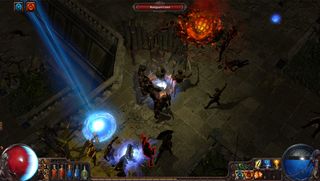
When it comes to game communities, bigger is better. More players means more support for the devs, who in turn will support the players with constant updates, bug fixes, and new servers. And whats the best way to get more gamers playing your game? Remove all barriers to entry by making it completely free. Even if you encounter server queues or sporadic lag as the game first finds its footing, getting it all free of charge means theres really nothing to complain about.
Grinding Gear Games will turn a profit via microtransactions--and theyve set up safeguards to protect their players from the Pay-to-Win bogeyman, a greed-fueled imbalance that can kill even the finest F2P game. Any purchases made with real-world cash will be purely aesthetic, in the form of non-combat pets and unique spell graphics that you can show off to your buddies. You can rest easy knowing that money cant buy power in PoE, unlike some action RPGs we know of coughDiabloIIIAuctionHousecough.
Our clicking fingers are ready
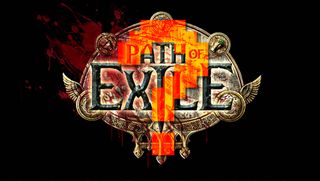
Those are the reasons were stoked for Path of Exile, and were amped to start playing it tonight (and likely for many nights to come). Whats your take on it? Let us know in the comments if youll be playing (you can sign up now at the Path of Exile website), and perhaps we can get some in-game GR action going.
For more action and/or RPG features, check out 10 turn-based JRPGs that dared to be different and why Far Cry 3 is the best Assassin's Creed of 2012.
Lucas Sullivan is the former US Managing Editor of GamesRadar+. Lucas spent seven years working for GR, starting as an Associate Editor in 2012 before climbing the ranks. He left us in 2019 to pursue a career path on the other side of the fence, joining 2K Games as a Global Content Manager. Lucas doesn't get to write about games like Borderlands and Mafia anymore, but he does get to help make and market them.
Most Popular



